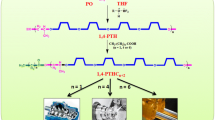Abstract
Three biodegradable polyalkylene glycols containing 1:1, 1:2 and 1:4 mol% fraction of propylene oxide and tetrahydrofuran were synthesized and denoted as 1,1-PTH, 1,2-PTH and 1,4-PTH. The synthesized polyalkylene glycols were subsequently treated with adipic acid to get desired esters. At first, three different copolymers of propylene oxide and tetrahydrofuran, namely 1,1-PTH, 1,2-PTH and 1,4-PTH (polyglycol containing 1:1, 1:2 and 1:4 mol% fraction of PO and THF), with molecular weights 564.0, 838.6 and 1070.7 were synthesized. Then, the esterification of the synthesized polyglycols was carried out using p-toluenesulfonic acid as the catalyst and toluene as a solvent. The obtained esters 1,1-PTHAD, 1,2-PTHAD and 1,4-PTHAD were observed to have the molecular weights 1292.1, 1705.0 and 2201.1, respectively. After molecular and physicochemical characterizations, the tribological properties were also evaluated. A comparison of the properties of these esters was made, and it was found that 1,1-PTHAD, 1,2-PTHAD and 1,4-PTHAD are favorably used as metalworking fluid, industrial gear oil and compressor lubricant base oil, respectively.
Graphical abstract






Similar content being viewed by others
References
Ranney MW (1973) Lubricant additives. Noyes Data Corporation, Park Ridge
Pawlak Z (2003) Tribochemistry of lubricating oils, 1st edn. Elsevier, Amsterdam
Roy M, Mortier RM, Fox MF, Orszulik ST (2010) Chemistry and technology of lubricants. Springer, Heidelberg
Rudnick LR (2009) Lubricant additives: chemistry and applications, 2nd edn. CRC Press, Boca Raton
Gunderson RC, Hart AW (1962) Synthetic lubricants. Reinhold Publ. Co., New York
Booser ER (1993) CRC handbook of lubrication volume III: monitoring, materials, synthetic lubricants, and applications. CRC Press, London
Hund K, Gralms U, Buenemann T (1994) Investigation of the biodegradation process of a synthetic lubricant base stock. Chemosphere 28(4):813–823
Okpokwasili GC, Okorie BB (1991) Influence of physico-chemical stress on biodegradability of car engine lubricating oil. Int Biodeterior Biodegradation 27:255–264
Greaves M (2011) Oil soluble synthetic polyalkylene glycols: a new type of group V base oil. Lube Mag 104:21–24
Kukrety A, Singh RK, Ray SS (2018) Development of a biodegradable/ecofriendly turbine lubricant from a novel polyalkylene glycol ester. Waste Biomass Valorization 9:1121–1128
Herzberger J, Niederer K, Pohlit H, Seiwert J, Worm M, Wurm FR, Frey H (2016) Polymerization of ethylene oxide, propylene oxide, and other alkylene oxides: synthesis, novel polymer architectures, and bioconjugation. Chem Rev 116:2170–2243
Greaves MR (2013) Polyalkylene glycols. In: Rudnick LR (ed) Synthetics, mineral oils and biobased lubricants, 2nd edn. CRC Press, Boca Raton
Yu SJ, Liu Y, Byeon SJ, Park DW, Kim I (2014) Ring-opening polymerization of propylene oxide by double metal cyanide catalysts prepared by reacting CoCl2 with various metal cyanide salts. Catal Today 232:75–81
Rose JB (1956) 111. Cationic polymerization of oxacyclobutanes. Part I. J Chem Soc. https://doi.org/10.1039/JR9560000542
Akedo T (2002) Process for producing tetrahydrofuran polymer. US patent no. 6,414,109 B1
IS 1115 (1986) General purpose cutting oil, soluble. Bureau of Indian Standards (BIS), New Delhi
IS 8406 (1993) Gear lubricants for enclosed industrial gear drives. Bureau of Indian Standards (BIS), New Delhi
IS 13256 (1992) Air compressor lubricants. Bureau of Indian Standards (BIS), New Delhi
ASTM D 445-15 (2015) Standard test method for kinematic viscosity of transparent and opaque liquids (and calculation of dynamic viscosity). Annual book of ASTM standards. ASTM International, West Conshohocken
ASTM D 2270-10 (2010) Standard practice for calculating viscosity index from kinematic viscosity at 40°C and 100°C. Annual book of ASTM standards. ASTM International, West Conshohocken
IS 7895 (2002) Tests for fire resistant characteristics of hydraulic fluids used in mining machinery. Bureau of Indian Standards (BIS), New Delhi
ASTM D 97-16 (2016) Standard test method for pour point of petroleum products. Annual book of ASTM standards. ASTM International, West Conshohocken
IS 1448 (2012) Methods of test for petroleum and its products. Bureau of Indian Standards (BIS), New Delhi
IP 48 (2012) Determination of oxidation characteristics of lubricating oil. Institute of Petroleum, Great Britain
IP 239 (2007) Determination of extreme pressure and anti-wear properties of lubricating fluids and greases—four ball method (European conditions). Institute of Petroleum, Great Britain
ASTM D 4172 (2016) Standard test method for wear preventive characteristics of lubricating fluid (four-ball method). Annual book of ASTM standards. ASTM International, West Conshohocken
ASTM D 5864 (2011) Standard test method for determining aerobic aquatic biodegradation of lubricants or their components. Annual book of ASTM standards. ASTM International, West Conshohocken
Yadav M, Sharma D, Sarkar TK (2015) Adsorption and corrosion inhibitive properties of synthesized hydrazine compounds on N80 steel/hydrochloric acid interface: electrochemical and DFT studies. J Mol Liq 212:451–460
Acknowledgements
The author kindly acknowledges the Director, IIP, for his kind permission to publish these results. The author thanks the Analytical Division of the Institute for providing analysis. CSIR, New Delhi, is acknowledged for research funding. One of the co-authors Dr. Tarun Kanti Sarkar acknowledged DST-SERB for financial help, file no. PDF/2017/002682.
Author information
Authors and Affiliations
Corresponding author
Ethics declarations
Conflict of interest
The authors declare no competing financial interest.
Additional information
Publisher's Note
Springer Nature remains neutral with regard to jurisdictional claims in published maps and institutional affiliations.
Rights and permissions
About this article
Cite this article
Kukrety, A., Sarkar, T.K., Faujdar, E. et al. Adipates of poly(propylene oxide-co-tetrahydrofuran) as a novel base stock for varied lube applications. Polym. Bull. 76, 5415–5431 (2019). https://doi.org/10.1007/s00289-018-2661-y
Received:
Revised:
Accepted:
Published:
Issue Date:
DOI: https://doi.org/10.1007/s00289-018-2661-y




